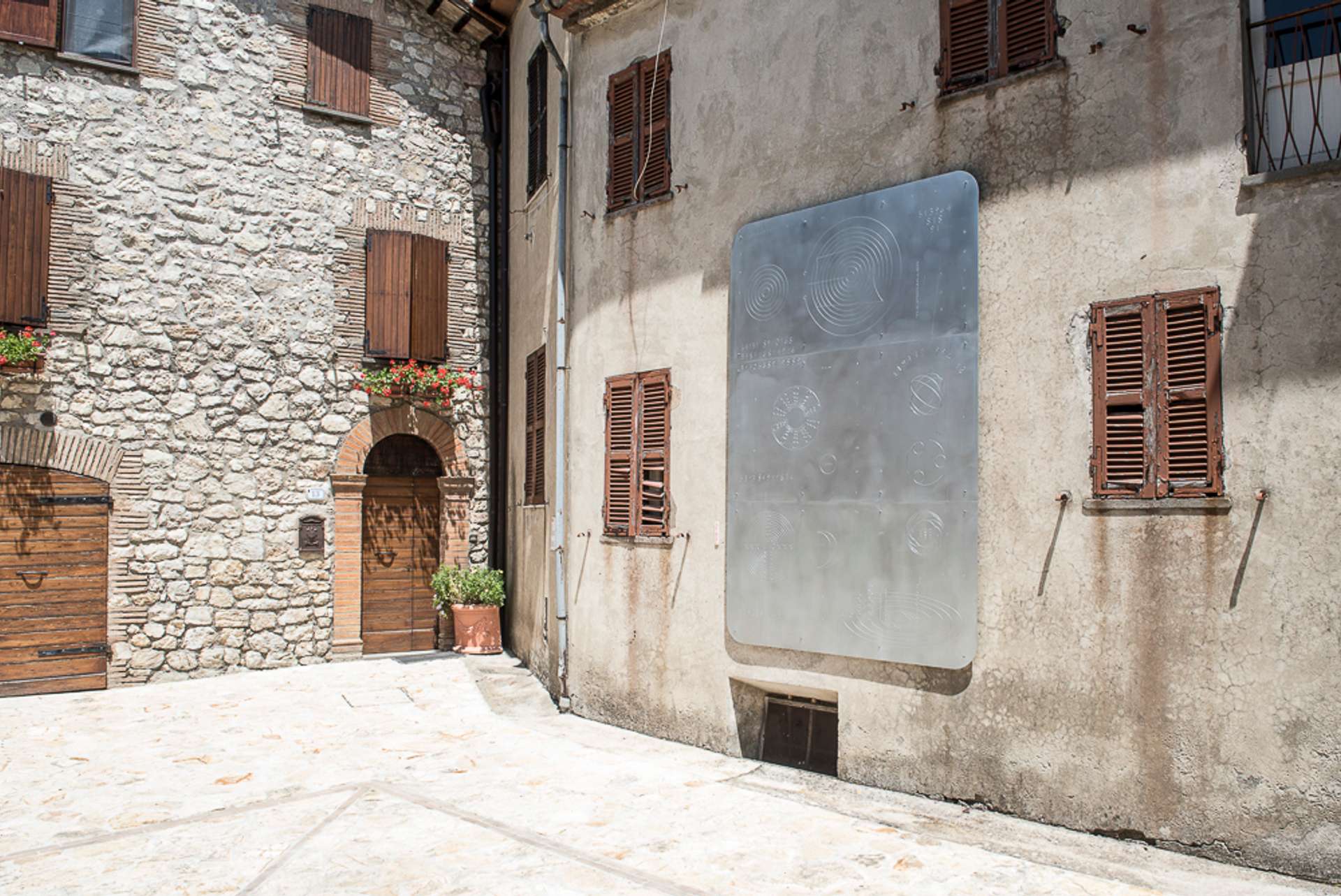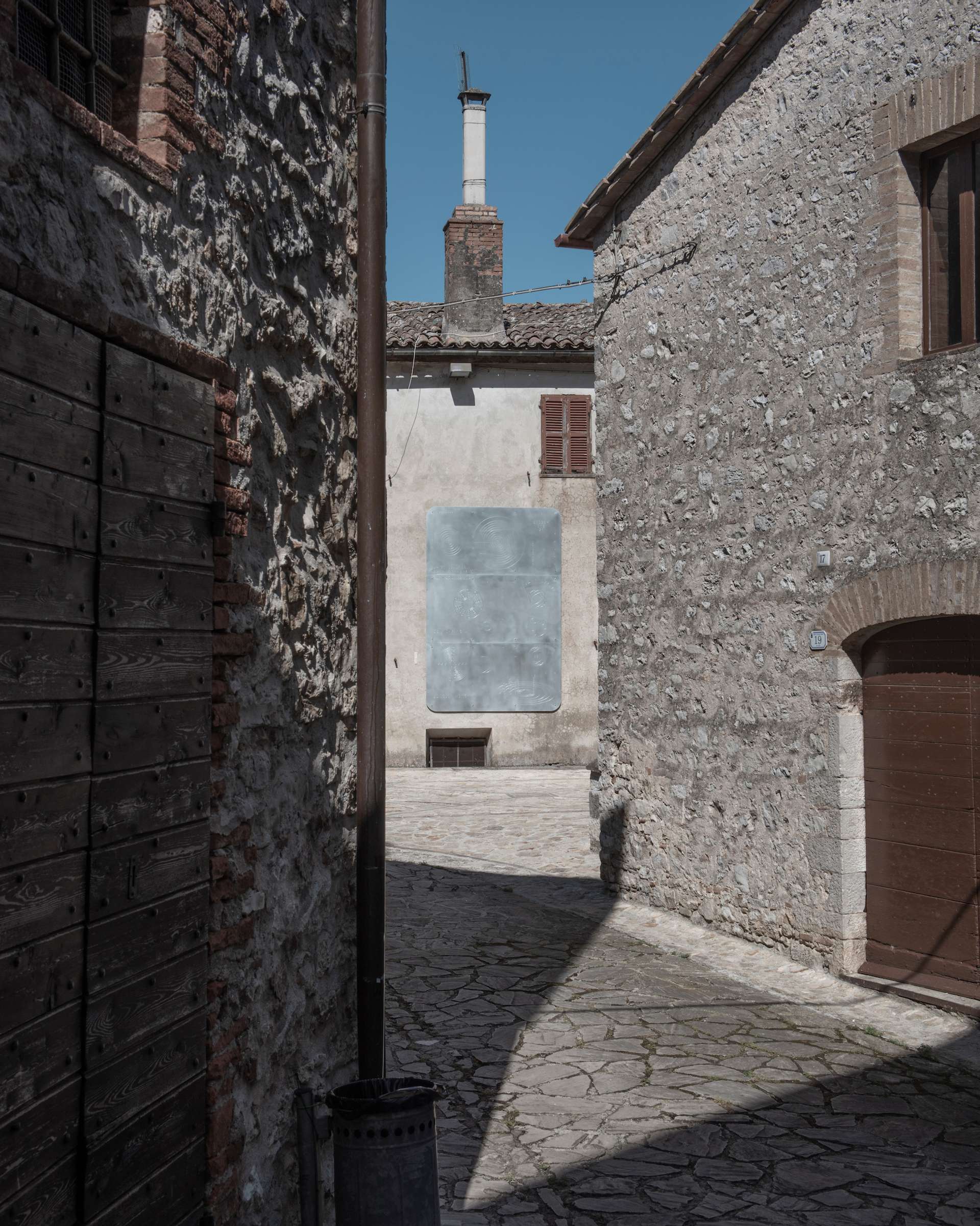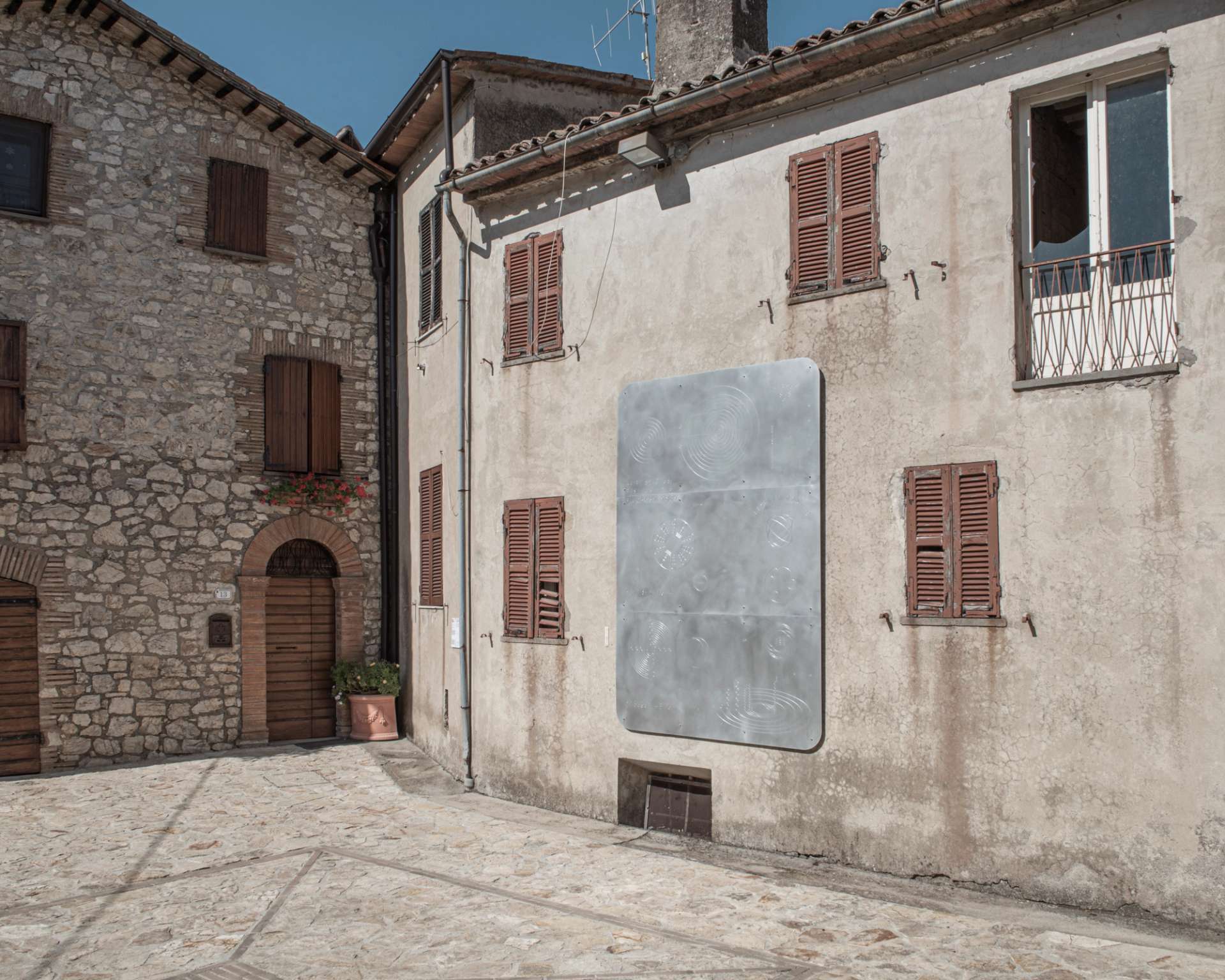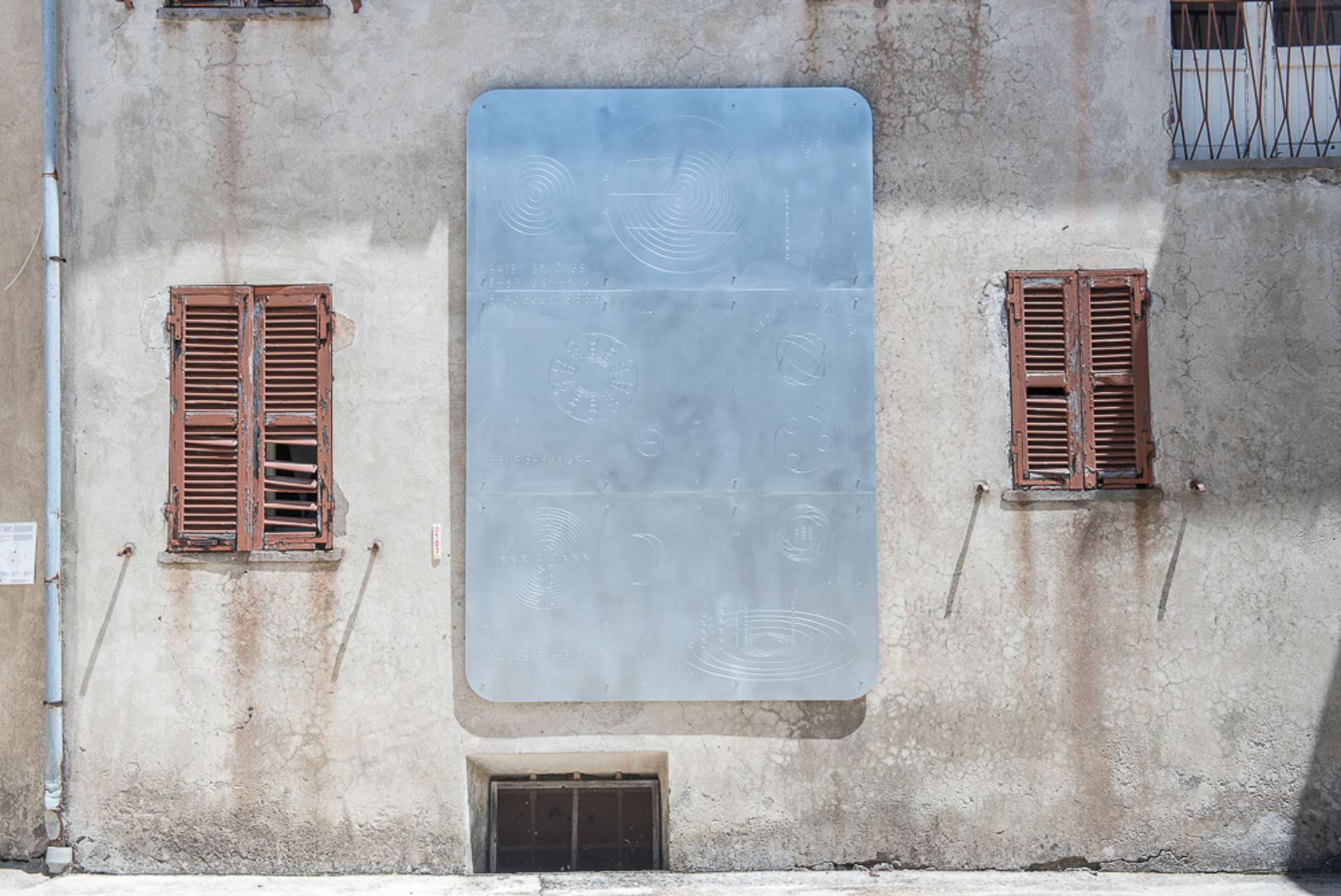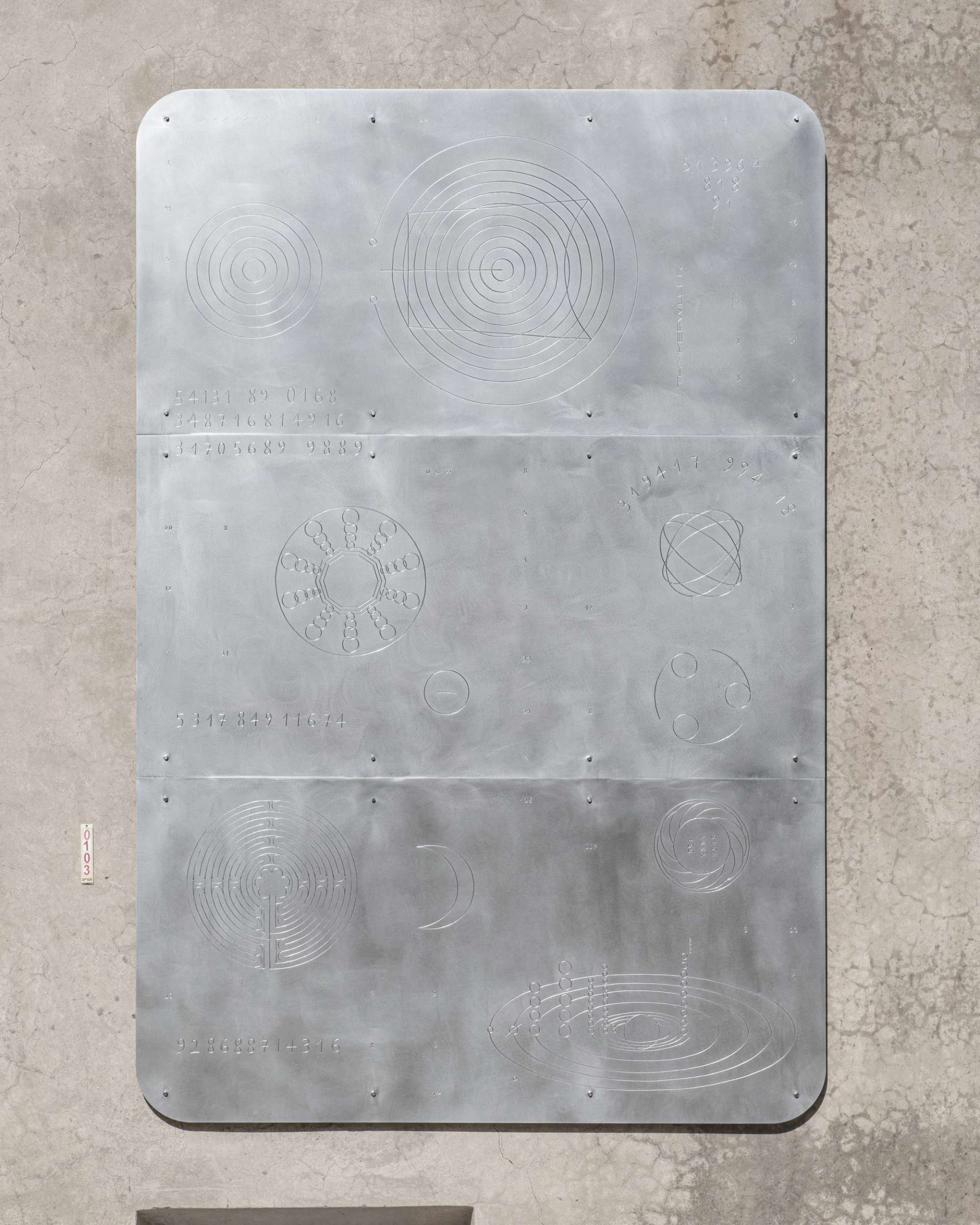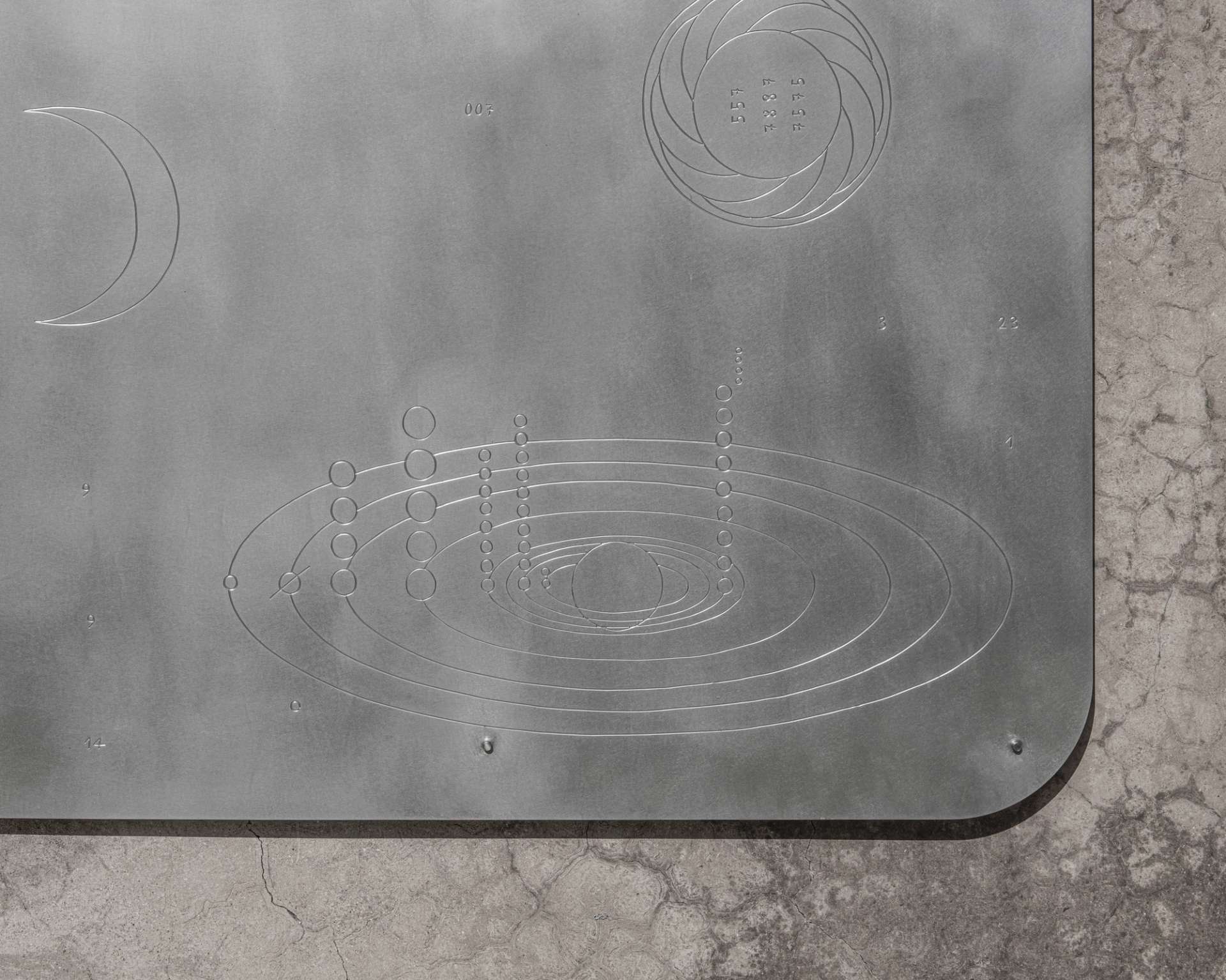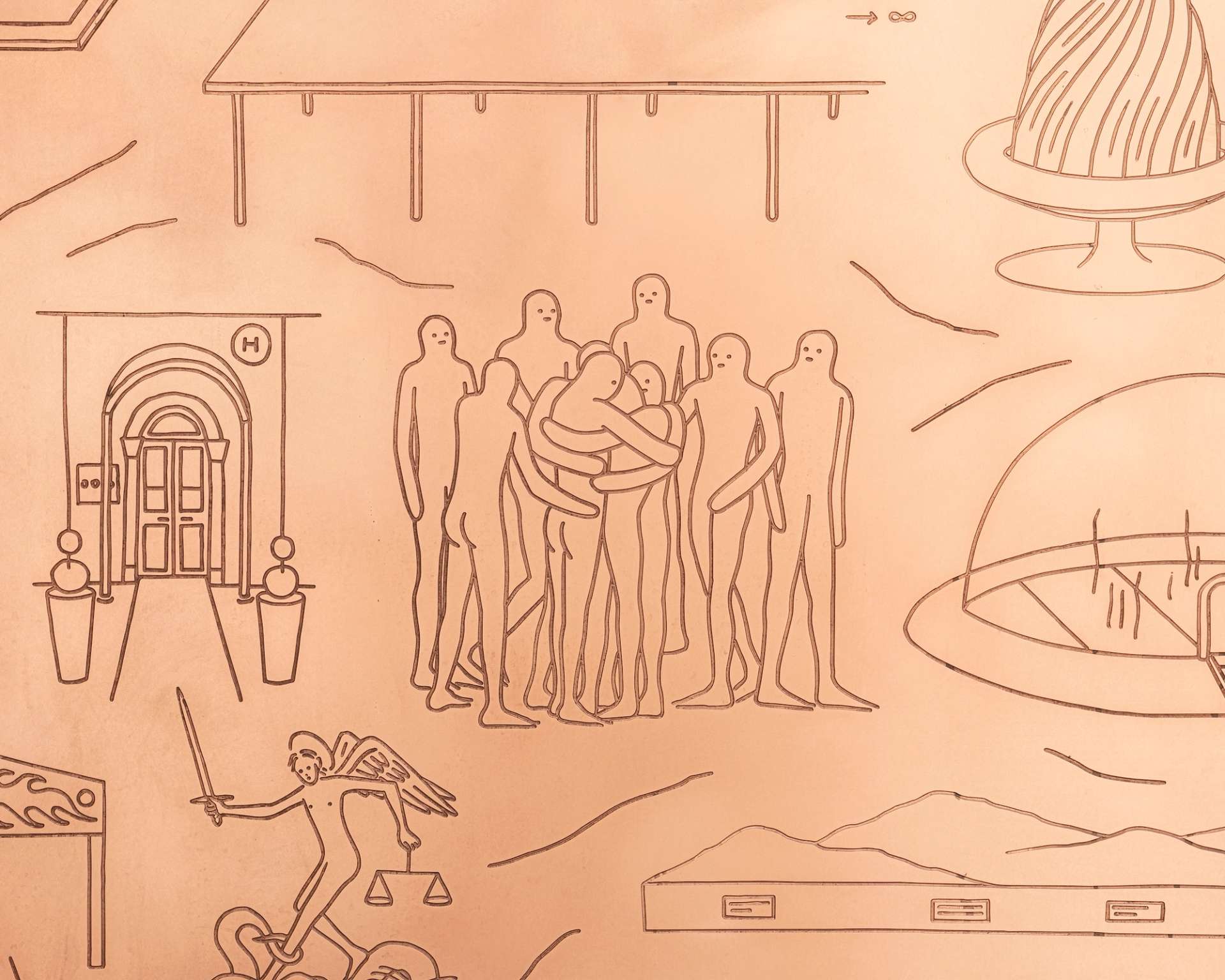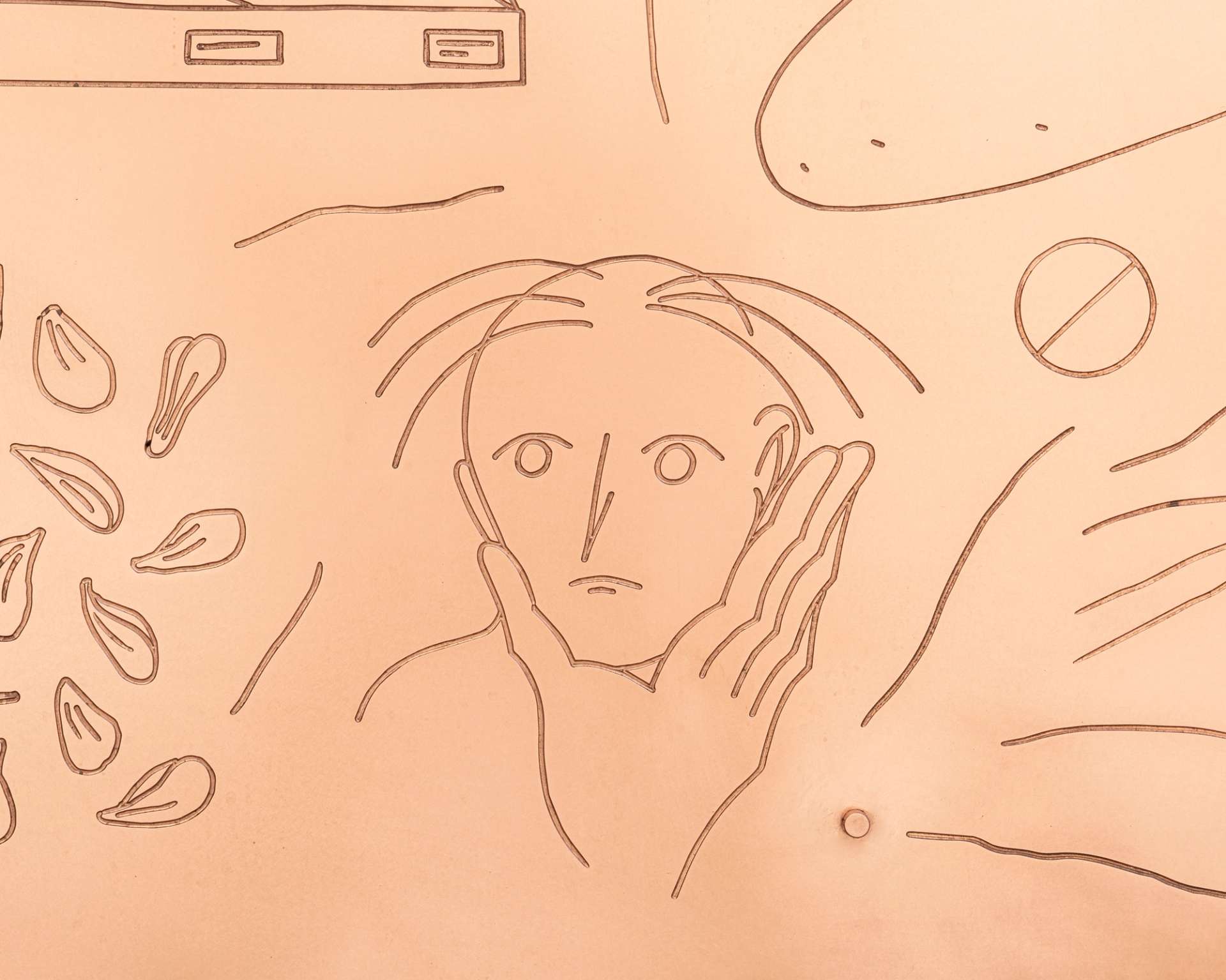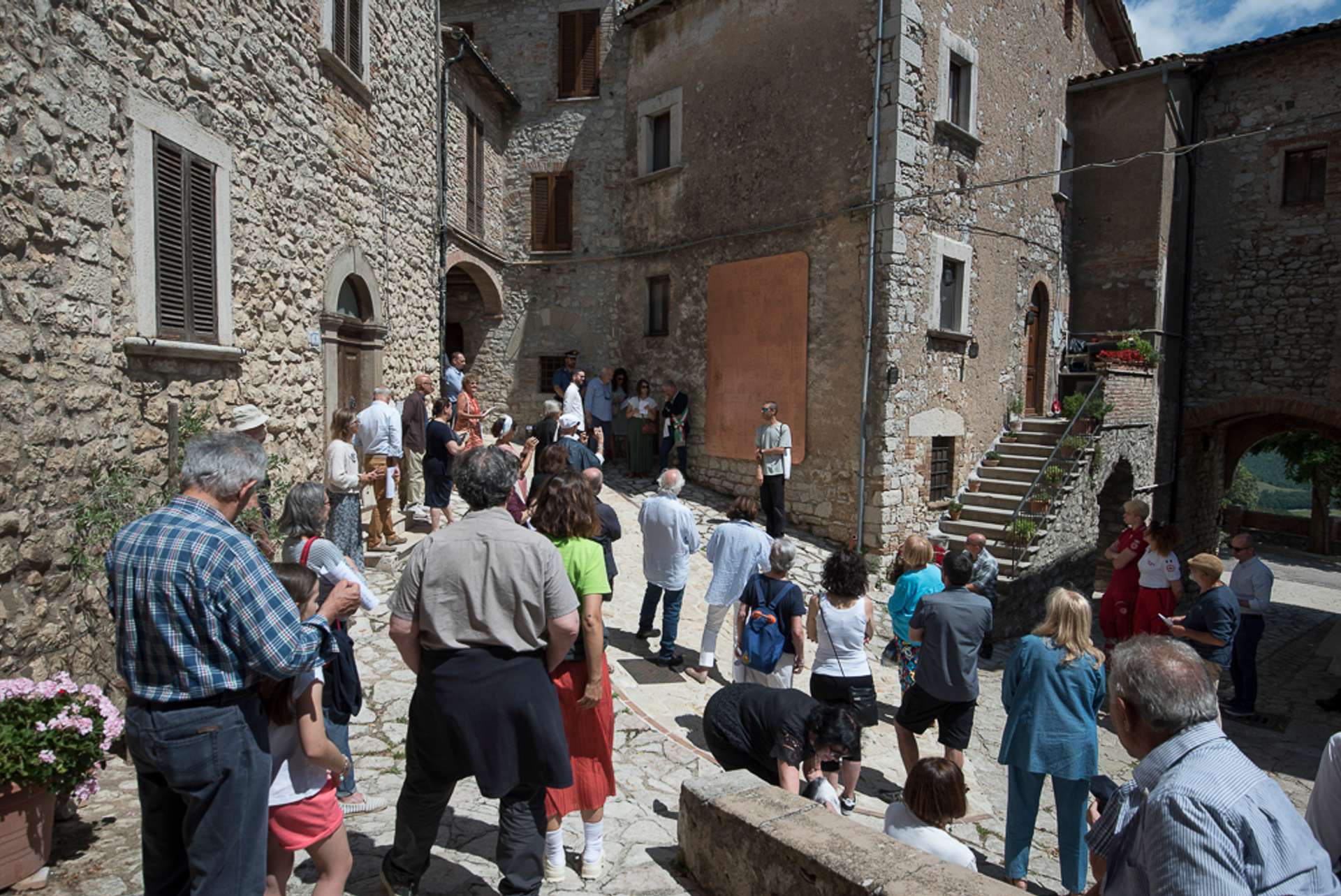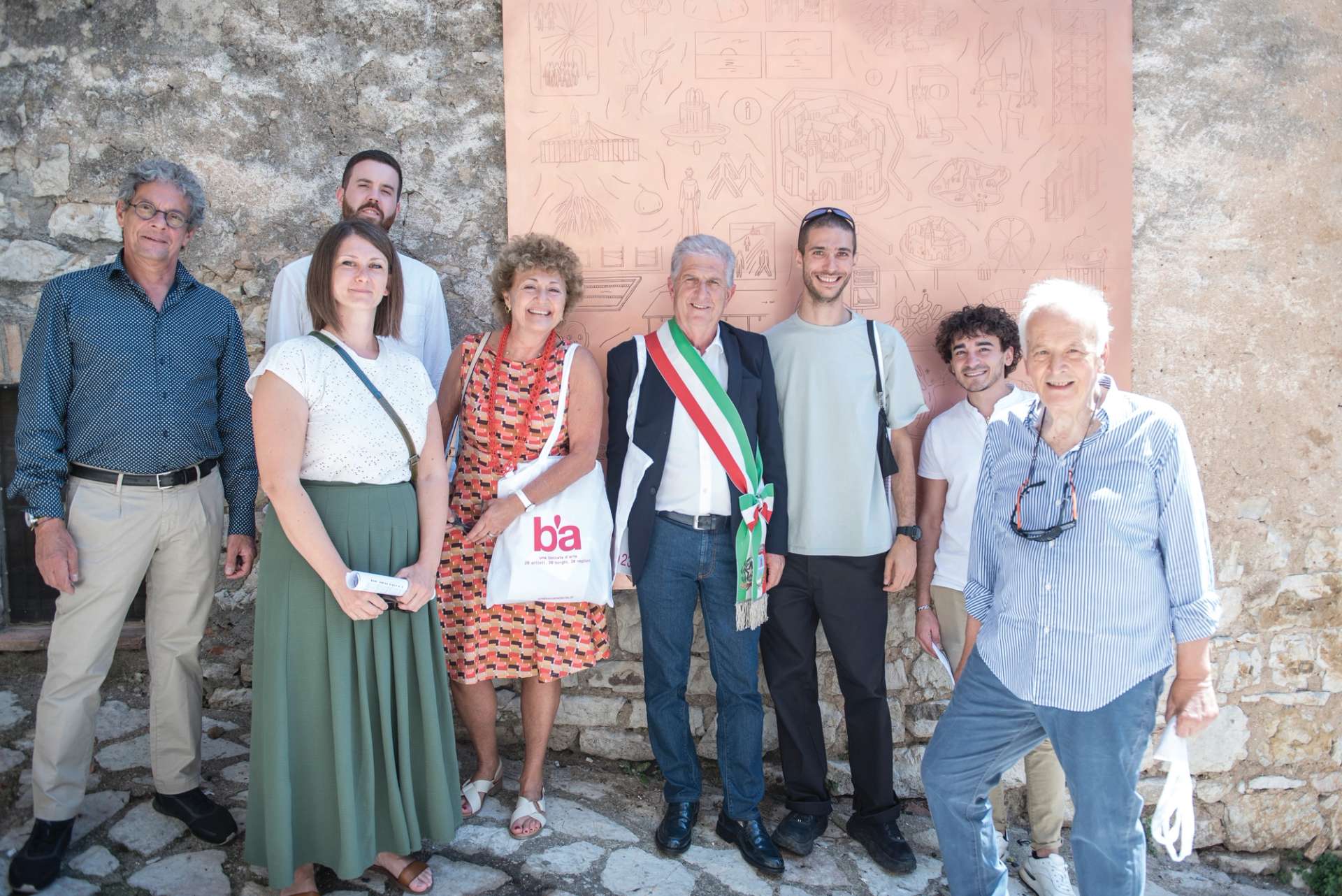Pila Thinkerwiller is a work consisting of two engraved plates, one copper and one zinc, placed at the northern and southern ends of the village of Toscolano. These two elements are positioned at the cardinal points to imagine the village as a large battery, whose positive pole is represented by the copper plate and the negative pole by the zinc plate.
The copper plate contains a composition of ideas of the inhabitants of Toscolano, collected by the artist during his stay in the village, describing possible and impossible urban, architectural and artistic operations that do not yet exist. The zinc plate, on the other hand, shows geometric shapes, numbers and diagrams. In this composition, the inhabitants’ favourite numbers and planets are presented alongside symbols, radionic tables and numerical sequences that should have the power to foster the fulfilment of the ideas engraved on the first plate.
The use of copper and zinc is a reference to the first static electricity generators invented in the late 18th and early 19th centuries by Alessandro Volta and John F. Daniell. Another reference is to the initiatory techniques of a small mountain community in the Caucasus, recorded in a 1955 manuscript by Stefan C. Walewski, according to which copper and zinc are the fundamental materials for the construction of analogue devices that generate a micro-current in the human body, useful for rebalancing vital energies and amplifying the user’s intentions. Pila Thinkerwiller redevelops this technique, transferring its presumed functioning from the human body to the inhabited village.
The artist is interested in the revival of magical, initiatory and pseudoscientific theories and techniques from an aesthetic and speculative point of view, in the wake of the urgent need to understand exactly what truth is and how it can be ascertained.
Pila Thinkerwiller is an amplifier of ideas, a portrait of a time, a place and a community.
ㅤ
Permanent works:
01. Mattia Pajè, Pila Thinkerwiller (+), 2023. Milling machine engraving on copper plate, 300 x 200 cm.
Piazza S. Apollinare, Toscolano - Avigliano Umbro (TR)
02. Mattia Pajè, Pila Thinkerwiller (-), 2023. Milling machine engraving on zinc plate, 300 x 200 cm.
Vico Pietro Micca, Toscolano - Avigliano Umbro (TR)
"PILA THINKERWILLER" IS AN ANALOGUE DEVICE THAT TURNS ON AT THE MOMENT IT IS INSTALLED AND CONTAINS THE PORTRAIT OF A TIME, A PLACE AND A COMMUNITY, CREATED FROM THE IDEAS OF THE PEOPLE WHO LIVE IN TOSCOLANO
Mattia Pajè (Melzo, 1991) lives and works in Bologna and Lisbon; in 2016 he received a diploma from the Academy of Fine Arts in Bologna. His work is hallmarked by the use of a variety of materials and approaches that are appropriate for the situations in which he finds himself operating. His extensive and diverse oeuvre includes pictorial, sculptural, installation, multimedia and performance works. In 2016, he became the artistic director of LOCALEDUE, a non-profit organisation for contemporary art in Bologna. In the same year he co-founded the artist-run space Gelateria Sogni di Ghiaccio, for which he currently handles artistic direction. In 2019 he co-founded the Bagni d’Aria residency and since 2018 he has been part of the nomadic organisation Altalena. His activities, in the form of specific projects, residencies, solo and group exhibitions, have received attention from many public and private institutions, including: ArtCity Bologna (IT, 2022); Alchemilla, Bologna (IT, 2021 and 2022); Istituto Italiano di cultura, Paris (FR, 2021); MAMbo, Bologna (IT, 2020 and 2021); Pinacoteca Nazionale, Bologna (IT, 2020); Sonnenstube, Lugano (CH, 2020); Fondazione Smart - polo per l’arte, Rome (IT, 2019); Centro per l’arte contemporanea Luigi Pecci, Prato (IT, 2017); S.a.L.E. Docks, Venice (IT, 2017); Dolomiti Contemporanee, Borca di Cadore (IT, 2017); Mahler & LeWitt Studios, Spoleto (IT, 2017); Cripta 747, Turin (IT, 2017); Istituto Italiano di Cultura, Montevideo (UY, 2017); LOCALEDUE, Bologna (IT, 2015).
THE WORK COMPRISES OF TWO ENGRAVED METAL PLATES WHICH, PLACED AT THE NORTH AND SOUTH ENDS OF THE VILLAGE, BRING TOGETHER THE PROJECTS OF THE INHABITANTS THEMSELVES, TRANSFORMING THE VILLAGE INTO A LARGE STACK, AN AMPLIFIER OF IDEAS, THE PORTRAIT OF A MOMENT, A PLACE AND A COMMUNITY
Toscolano is a small medieval village of only 66 inhabitants, packed with history and charm. It has a splendid circular shape and it is surrounded by fortified walls dating back to 1200 with viewpoints and terraces overlooking a panorama that allows the eye to see as far as the peaks of the Sibillini Mountains. The Middle Ages echo in every step, from the small squares to the alleys, which have remained almost completely intact through the centuries. On the only access road, the visitor is greeted by the tiny Chapel of the Santissima Annunziata (Most Holy Annunciation) with important frescoes and a mysterious octagonal cross of knightly origin. Inside the walls is the Church of Sant'Apollinare with important paintings as well as a 19th-century organ and relics dating back to the Knights Templar. Toscolano was the birthplace of Fra Faostino, an illustrious diplomat and traveller who maintained relations between the Papacy and the Sultanate of Constantinople in the 17th century, and to whom we owe the valuable account ‘Itinerario di Terra Santa’ (Itinerary of the Holy Land). The area is now home to the Centro Europeo di Toscolano, a music school founded by Mogol, the famous lyricist.
A stop on the ‘Cammino dei Borghi Silenti’ (Way of the Silent Villages) and recognised as the ‘Borgo Medievale del Viaggiator Cortese’ (Medieval Village of the Courteous Traveller), this location is an architectural treasure trove and it is part of that somewhat hidden Umbria, capable of giving visitors the pleasure of discovery.
